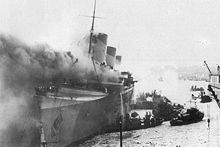

Operation Underworld was the United States government's code name for its co-operation with the Italian-American Mafia and Jewish organized-crime figures from 1942 to 1945. The operation aimed to counter Axis spies and saboteurs along the U.S. northeastern seaboard ports, to avoid wartime labor-union strikes, and to limit theft by black marketeers of vital war supplies and equipment.

In the first three months after the Japanese attack on Pearl Harbor on December 7, 1941, the U.S. lost 120 merchant ships to German U-boats and surface raiders in the Battle of the Atlantic, and in February 1942 the ocean liner SSNormandie, a captured French ship that was being refitted as a troop ship in New York Harbor, was allegedly sabotaged and sunk by arson in the Port of New York. Mafia boss and one-time Murder, Inc. head Albert "Mad Hatter" Anastasia allegedly claimed responsibility for the sabotage, according to Jewish mobster Meyer Lansky and Charles "Lucky" Luciano, one of the bosses of the New York Mafia's Five Families and the founder of the American Mafia's Commission.[1]
The United States government portrayed the loss of Normandie as an accident, and no evidence was ever produced linking Axis spies to the loss of Normandie. After the war, Axis records claimed no sabotage operation had existed, and no evidence has ever been produced by the Allies to indicate there had been underworld sabotage.[2] In 1954, a report looking into the contacts between US Naval Intelligence and the New York Mafia by William B. Herlands also did not mention Anastasia's role in the sabotage.[1]
Nevertheless, fears about possible sabotage or disruption of the waterfront led Commander Charles R. Haffenden of the U.S. Navy Office of Naval Intelligence (ONI) Third Naval District in New York to set up a special security unit. He sought the help of Joseph Lanza, who ran the Fulton Fish Market, to get intelligence about the New York waterfront, control the labor unions, and identify possible refueling and resupply operations for German submarines with the help of the fishing industry along the Atlantic Coast.[citation needed]
To cover Lanza's activities, Haffenden also approached Lansky, who had previously broken up pro-Nazi German-American Bund rallies, including one in Manhattan's Yorkville German neighborhood that he personally disrupted alongside fourteen associates.[3] He solicited Lansky's help in reaching Lansky's partner Luciano. Luciano had been tried and convicted in 1936 for compulsory prostitution and running a prostitution racket after District Attorney Thomas E. Dewey had investigated him for years and was serving a 30- to 50-year sentence at Dannemora.[citation needed]
Luciano agreed to cooperate with authorities in hopes of consideration for early release from prison.[4] In addition to Lansky and the Jewish gangsters wanting revenge for the Nazis' oppression of Jews, Luciano and the Mafia also wanted revenge on Benito Mussolini and the Fascist regime in Italy after Mussolini had directed Prefect of Palermo Cesare Mori to eradicate the Sicilian Mafia.[citation needed] By 1928, Fascists had arrested over 11,000 suspected Mafia members and driven many more to flee Sicily, including future Five Families bosses Joseph Bonnano and Carlo Gambino.[citation needed]
Luciano's contacts allegedly assisted in Operation Husky, the Allied Forces’ 1943 amphibious invasion of Sicily by providing maps of the island's harbors, photographs of its coastline and names of trusted contacts inside the Sicilian Mafia, who also wished to see Mussolini toppled. Luciano directed Calogero Vizzini to assist the Allies in the invasion of Italy.[citation needed] Vizzini became the central character in the history of direct Mafia support for the Allies during Operation Husky, spending 6 days on an American tank guiding Allied forces through the mountain pass and directing his Sicilian Mafia to eliminate Italian snipers in the mountains. Just over two weeks after Operation Husky began, Mussolini was deposed on July 25th.[citation needed]
For his cooperation, Luciano was moved to a more convenient and comfortable open prison in Great Meadows in May 1942.[5] Luciano's influence in stopping sabotage remains unclear, but authorities did note that strikes on the docks stopped after Luciano's attorney Moses Polakoff contacted underworld figures with influence over the longshoremen and their unions.[6] In 1946, Luciano's sentence was commuted after he had served 9½ years. He was deported to Italy as part of the provisions of his sentence being commuted and died in 1962 in Naples.[7]
While mafiosi supported the US Army, recent research has led most serious historians to dismiss the legend of Luciano's role in the invasion of Sicily.[8][9][10][11][12][13] According to historian Salvatore Lupo:
"The story about the Mafia supporting the Anglo-Americans with the invasion in Sicily is just a legend without any foundation, on the contrary there are British and American documents about the preparation of the invasion that refute this conjecture; the military power of the Allies was such that they did not need to use such measures."[14][15]
Lansky recalled breaking up a Brown Shirt rally in the Yorkville section of Manhattan: "The stage was decorated with a swastika and a picture of Hitler. The speakers started ranting. There were only fifteen of us, but we went into action. We … threw some of them out the windows…Most of the Nazis panicked and ran out. We chased them and beat them up…We wanted to show them that Jews would not always sit back and accept insults."
{{cite web}}: CS1 maint: bot: original URL status unknown (link) , Salvatore Lupo, testo della conferenza 60º anniversario della Liberazione, Catania, February 22, 2005